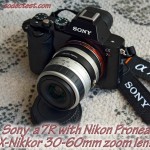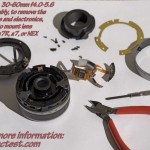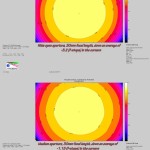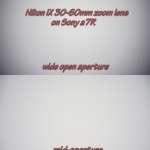Sony a7R NEX e-mount camera with cheap IX-Nikkor 30-60mm lens
One of the most appealing features of the Sony NEX a7 a7R a6000 mirrorless cameras is the size. When you have a small camera body like that, you want to use a small and light camera lens with it. There are legacy film and DSLR prime lenses that are more than up for that small size challenge, but are there any really small zoom lenses?
Some of the smallest zooms ever built were the IX-Nikkor lenses, sold with the Nikon Pronea cameras, starting in about 1996 or so. The Pronea used APS film, which was a 23.4mm x 16.7mm format. That is comparable in size to the modern APS-C digital sensor size, but it’s considerably smaller than the Sony a7 and a7R 35mm film full-frame size of 24mm x 36mm.
So if the IX-Nikkor lens could be mounted to an APS-C digital camera, it would cover the sensor size, but would it work for a full-frame sensor camera? The IX-Nikkor lenses use the standard Nikon F mount, but they protrude well into the camera body, which is fine for mirrorless cameras, but not so good for a DSLR.
The Sony NEX 7, NEX 6, a7, a7R, a6000, etc., use commonly available e-mount adapters for Nikon lenses. However, since modern Nikon lenses don’t have aperture rings on the outside, you’ll need a NEX e-mount adapter with a rotating collar, that has an internal pin attached to the inside of the collar. The pin actuates the aperture lever sticking out of the inside of the lens. Be aware that not all modern Nikon lenses have an accessible aperture lever, the lenses that you want are typically labeled by Nikon with a “G” nomenclature. Nikon started removing the aperture rings in about the year 2000.
The IX-Nikkor lenses that the Nikon Pronea used don’t have aperture rings, and they aren’t labled as “G” lenses, but since they have aperture levers sticking out of the lens mount, they work fine with the right NEX e-mount adapter. The biggest problem you’ll have is trying to figure out where f8, f11, etc. are, because the rotating collars on the NEX e-mount adapters aren’t usually labeled. You’ll have to look into the lens to see how far the aperture is open, and then guess about what the aperture is.
Of course, that means full manual operation only. When the aperture is nearly closed(f11, for example), very little light is getting into the camera sensor, but the electronic viewfinder on the Sony a7R puts gain on the display you are looking at, and if you chose the correct setting in the a7R menu, what you’ll see in the EVF is what the picture will look like.
The Nikon Pronea IX-Nikkor lenses were all zooms, with focal lengths ranging from 20-60mm, 24-70mm, 30-60mm, and 60-180mm. The black versions of the lenses were usually made in Japan, while the silver lenses were made in Thailand. The 20-60mm is reputed to have been the most expensive of the bunch. These lenses are incredibly light, because they were built with a lot of plastic. Unfortunately one of the things that was left off was a decent focus ring; on the 30-60mm lens, you can barely grip the end of the lens to focus, so if the lens you are testing is good, get a couple of step-up rings to screw into the end of the lens, so that you’ll have something to grab for focusing.
How will IX-Nikkor lenses work for DSLR video use? They are plenty sharp enough, of course, given that video records far less resolution than still photographs capture. The NEX to Nikon-F adapter being used here is clickless, and so is the lens, so it’s perfectly quiet, but you’ll have to watch out, because you can’t see what the aperture is really set at. These lenses do not have parfocal capability, which means that they have to be re-focused every time that you zoom, which is typical for DSLR lenses. Lenses are a lot cheaper to manufacture when you don’t have to worry about holding focus through the zoom range.
At this point you’re probably wondering why anyone would want to go through this hassle. The answer is that these lenses are dirt cheap, extremely light, very small, and sharper than you might imagine. In order to mount the lens to the Sony NEX e-mount adapter, you may have to first remove the backing plate and electronics from the lens. With the lens sitting upside down, on it’s face, remove the screws from the lens mount, starting with the screws holding the electronic contacts mount. Pull the backing plate off, and cut the ribbon cable, if you don’t want to tear it apart any further. See the picture below for details.
Since we know that these APS lenses will cover the APS-C sensor size, the real question is, will these lenses cover the full-frame sensor size on the Sony a7 and a7R? How much vignetting will there be? Imatest vignetting testing of the 30-60mm IX-Nikkor on the Sony a7R shows that the worst case scenario, of a wide open aperture and the widest zoom setting, is -3.2(EV) dark in the corners. That is very noticeable, but if you look at the Imatest results for the new and very expensive Sony FE 35mm 2.8 prime lens that was designed for the a7R, you’ll see that it’s at -2.6(EV): http://www.photozone.de/sonyalphaff/865-zeiss35f28ff?start=1
So the 30-60mm lens is fully usable on the full-frame sensor, depending on aperture, and how much corner correction you can live with in the edit suite. The pictures below show the Imatest.com vignetting test results for the 30-60mm IX-Nikkor lens. When you are looking at the colored circles, it’s the numbers that matter, not the colors. The numbers indicate how dark the overall picture area is, since vignetting affects further into the frame than just the corners. Vignetting testing was done at the 30mm focal length.
What about picture quality? Sharp in the middle, but unfortunately the lens being evaluated was decentered, so we’ll have to get another one to test. Not to worry, though, because the 20-60 lens shots are about ready to upload.
Dan Euritt







hi, I love tinkering with old lenses and nikkor ix was one of my candidate to adapt to modern mirrorless mounts. But it is hard to get them in where i live (Asia). I would like to know why you disassemble the lens rear mount to take the electronics off? Given the flange distance of Nikon F mount and Sony E mount difference of 26mm, will the rear part if the lens still hit the camera internals? Or is there other reason? Still, it is a wonderful adaptation. Bravo…
hi alston… the reason that i butchered the mount was because these ix-nikkor lenses have a weird stepped flange configuration that interfered with the fotodiox n/g-nex adapter that i’m using.
just last week i got a second 30-60 ix-nikkor lens, that also has an issue with one side, it’s blurry… i’ve now looked at two of those lenses and the 20-60 ix-nikkor, which had weird out of focus areas in the image plane, at certain focal lengths only.
i also tested a full-frame plastic nikon 28-80, with a blurry spot at one focal length… it’s all a bit discouraging, but the good news is that these ix-nikkors are perfect for aps-c, the side issues that i saw on the full-frame sony a7r wouldn’t be much of an issue for a crop sensor… get the 20-60 if you can find it.